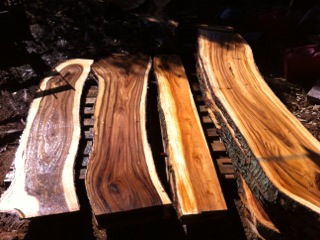Well it happened like this:
The dehumidifier in a box method of kiln drying wasn't cutting it anymore so we decided it was time to build/buy a kiln. We shopped a few friend's set ups, decided Nyle wasn't what we were looking for (foolishly perhaps), and solar kilns seemed to be more hassle than they were worth since our warehouse is essentially a 60 day 4/4 solar kiln and 180 day 8/4 solar kiln. But we needed something to get certain materials from sawn to market in 30 days or less. So being self proclaimed geniuses (me esp.) we made the decision to go with the Logosol Sauno 4kW steam kiln. You know because having another complicated overeas built machine with replacement part supply issues and poor customer service is just what any small biz. needs to improve efficiency right? Well, the hype was grand, and though there were no Baileys reviews there were a few initial positives on the wood forums....
$1700.00 on the shoebox unit and $900.00 on EPS foam later, we had a 1000BF+ styrofoam wood drying monstrosity taking up most of my shop.
Wired it up, hit the switch and..... zzzzzzzz the contactor failed to engage. For those of you wondering what a contactor is, its an electromagnetic switch that provides positive connection for high voltage applications such as motor controls, commerical lighting ( street lights, high bay lights etc.) and its supposed to work when the inspector(me) wires it correctly. So there I was, successfully built the kiln box in record time, wired the system per diagram
Which BTW I accomplished even though directions were in swedish: Hallå! I'm not stupid...
So what's the deal right? The folks at Baileys in typical form had no answer, the Swedes were slow to come to the party. Finally they sent out a new contactor and that was a relief, swapped it out and...... zzzzzzzz the contactor failed to engage.
Two of my most astute and trusted electrical contractor friends came to the rescue.
"Oye... you need a step up step down voltage transformer..."
Whatever for I wonder...
"Well see the wiring diagram says 220 volts on each leg of the device..."
Well
so what right? Bad instructions I figure...

"Well here in the states we don't have 220 volts in residential applications.."
??!!?? Huh, well I thought, 110v 220v after all I am the building inspector when I'm not pretending to be a kiln operator apparently.
"See its like this: We run 120v 60Hz power and the folks on the other side of the pond(Hallå!) Well they run 220V 50Hz, and we step up our voltage for big tools like saws kilns etc, from 120 to 240V.
They have everything on 220V so they just pump more juice."
Its 120V 240V, 220 is a misnomer. Learn something new everyday I guess...
And so it went, step up step down converters etc. long and the short of it I had a swedish version not a US version and I'm in the middle of the pacific far from any simple solutions.
To the rescue my other good friend and extremely astute electrical contractor, who formerly wired in France the other place with (220V 50hz power) took one look at the situation and identified the contactor ( in 5 seconds flat) as simply needing a 120V coil instead of a 220V coil. Something that I might add(Hallå!) that the Logosol folks or their 3rd party manuf. Plano AB failed to figure out after about a dozen detailed emails on the subject, must have been a language barrier (Hallå!)
Interestingly Logosol doesn't make a kiln for our US voltages, but their US distributer sells them anyway huh?
So to the rescue and the oracle we went and through mighty GOOG, we found Kent industries who provided us with the correct contactor from CH Eaton... and we be cooking now!
KD lumber now available in select species and quantities.
Currently available KD Kiawe' in 4/4 8/4 shorts and slabs. KD Koa 4/4 8/4 Shorts and RWL. KD cypress 4/4 8/4 RWL KD Mango spalted and curly live edge slabs and RWL, and KD Toon 4/4 8/4 in RWL.





























